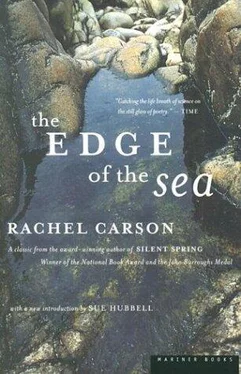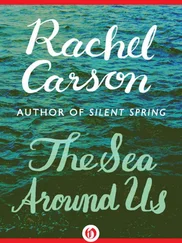Rachel Carson - The Edge of the Sea
Здесь есть возможность читать онлайн «Rachel Carson - The Edge of the Sea» весь текст электронной книги совершенно бесплатно (целиком полную версию без сокращений). В некоторых случаях можно слушать аудио, скачать через торрент в формате fb2 и присутствует краткое содержание. Город: Boston, Год выпуска: 1998, ISBN: 1998, Издательство: Mariner Books, Жанр: Биология, sci_ecology, sci_popular, на английском языке. Описание произведения, (предисловие) а так же отзывы посетителей доступны на портале библиотеки ЛибКат.
- Название:The Edge of the Sea
- Автор:
- Издательство:Mariner Books
- Жанр:
- Год:1998
- Город:Boston
- ISBN:978-0-395-07505-0
- Рейтинг книги:4 / 5. Голосов: 1
-
Избранное:Добавить в избранное
- Отзывы:
-
Ваша оценка:
- 80
- 1
- 2
- 3
- 4
- 5
The Edge of the Sea: краткое содержание, описание и аннотация
Предлагаем к чтению аннотацию, описание, краткое содержание или предисловие (зависит от того, что написал сам автор книги «The Edge of the Sea»). Если вы не нашли необходимую информацию о книге — напишите в комментариях, мы постараемся отыскать её.
A book to be read for pleasure as well as a practical identification guide,
introduces a world of teeming life where the sea meets the land. A new generation of readers is discovering why Rachel Carson’s books have become cornerstones of the environmental and conservation movements. New introduction by Sue Hubbell.
The Edge of the Sea — читать онлайн бесплатно полную книгу (весь текст) целиком
Ниже представлен текст книги, разбитый по страницам. Система сохранения места последней прочитанной страницы, позволяет с удобством читать онлайн бесплатно книгу «The Edge of the Sea», без необходимости каждый раз заново искать на чём Вы остановились. Поставьте закладку, и сможете в любой момент перейти на страницу, на которой закончили чтение.
Интервал:
Закладка:
Cape Cod has long been recognized in zoology as marking the boundary of the range for thousands of creatures. Thrust far into the sea, it interferes with the passage of the warmer waters from the south and holds the cold waters of the north within the long curve of its shore. It is also a point of transition to a different kind of coast. The long sand strands of the south are replaced by rocks, which come more and more to dominate the coastal scene. They form the sea bottom as well as its shores; the same rugged contours that appear in the land forms of this region lie drowned and hidden from view offshore. Here zones of deep water, with accompanying low temperatures, lie generally closer to the shore than they do farther south, with interesting local effects on the populations of shore animals. Despite the deep inshore waters, the numerous islands and the jaggedly indented coast create a large intertidal area and so provide for a rich shore fauna. This is the cold-temperate region, inhabited by many species unable to tolerate the warm water south of the Cape. Partly because of the low temperatures and partly because of the rocky nature of the shore, heavy growths of seaweeds cover the ebb-tide rocks with a blanket of various hues, herds of periwinkles graze, and the shore is here whitened by millions of barnacles or there darkened by millions of mussels.
Beyond, in the waters bathing Labrador, southern Greenland, and parts of Newfoundland, the temperature of the sea and the nature of its flora and fauna are subarctic. Still farther to the north is the arctic province, with limits not yet precisely defined.
Although these basic zones are still convenient and well-founded divisions of the American coast, it became clear by about the third decade of the twentieth century that Cape Cod was not the absolute barrier it had once been for warm-water species attempting to round it from the south. Curious changes have been taking place, with many animals invading this cold-temperate zone from the south and pushing up through Maine and even into Canada. This new distribution is, of course, related to the widespread change of climate that seems to have set in about the beginning of the century and is now well recognized—a general warming-up noticed first in arctic regions, then in subarctic, and now in the temperate areas of northern states. With warmer ocean waters north of Cape Cod, not only the adults but the critically important young stages of various southern animals have been able to survive.
One of the most impressive examples of northward movement is provided by the green crab, once unknown north of the Cape, now familiar to every clam fisherman in Maine because of its habit of preying on the young stages of the clam. Around the turn of the century, zoological manuals gave its range as New Jersey to Cape Cod. In 1905 it was reported near Portland, and by 1930 specimens had been collected in Hancock County, about midway along the Maine coast. During the following decade it moved along to Winter Harbor, and in 1951 was found at Lubec. Then it spread up along the shores of Passamaquoddy Bay and crossed to Nova Scotia.
With higher water temperatures the sea herring is becoming scarce in Maine. The warmer waters may not be the only cause, but they are undoubtedly responsible in part. As the sea herring decline, other kinds of fish are coming in from the south. The menhaden is a larger member of the herring family, used in enormous quantities for manufacturing fertilizer, oils, and other industrial products. In the 1880’s there was a fishery for menhaden in Maine, then they disappeared and for many years were confined almost entirely to areas south of New Jersey. About 1950, however, they began to return to Maine waters, followed by Virginia boats and fishermen. Another fish of the same tribe, called the round herring, is also ranging farther north. In the 1920’s Professor Henry Bigelow of Harvard University reported it as occurring from the Gulf of Mexico to Cape Cod, and pointed out that it was rare anywhere on the Cape. (Two caught at Provincetown were preserved in the Museum of Comparative Zoology at Harvard.) In the 1950’s, however, immense schools of this fish appeared in Maine waters, and the fishing industry began experiments with canning it.
Many other scattered reports follow the same trend. The mantis shrimp, formerly barred by the Cape, has now rounded it and spread into the southern part of the Gulf of Maine. Here and there the soft-shell clam shows signs of being adversely affected by warm summer temperatures and the hard-shell species is replacing it in New York waters. Whiting, once only summer fish north of the Cape, now are caught there throughout the year, and other fish once thought distinctively southern are able to spawn along the coast of New York, where their delicate juvenile stages formerly were killed by the cold winters.
Despite the present exceptions, the Cape Cod—Newfoundland coast is typically a zone of cool waters inhabited by a boreal flora and fauna. It displays strong and fascinating affinities with distant places of the northern world, linked by the unifying force of the sea with arctic waters and with the coasts of the British Isles and Scandinavia. So many of its species are duplicated in the eastern Atlantic that a handbook for the British Isles serves reasonably well for New England, covering probably 80 per cent of the seaweeds and 60 per cent of the marine animals. On the other hand, the American boreal zone has stronger ties with the arctic than does the British coast. One of the large Laminarian seaweeds, the arctic kelp, comes down to the Maine coast but is absent in the eastern Atlantic. An arctic sea anemone occurs in the western North Atlantic abundantly down to Nova Scotia and less numerously in Maine, but on the other side misses Great Britain and is confined to colder waters farther north. The occurrence of many species such as the green sea urchin, the blood-red starfish, the cod, and the herring are examples of a distribution that is circumboreal, extending right around the top of the earth and brought about through the agency of cold currents from melting glaciers and drifting pack ice that carry representatives of the northern faunas down into the North Pacific and North Atlantic.
The existence of so strong a common element between the faunas and floras of the two coasts of the North Atlantic suggests that the means of crossing must be relatively easy. The Gulf Stream carries many migrants away from American shores. The distance to the opposite side is great, however, and the situation is complicated by the short larval life of most species and the fact that shallow waters must be within reach when the time comes for assuming the life of the adult. In this northern part of the Atlantic intermediate way-stations are provided by submerged ridges, shallows, and islands, and the crossing may be broken into easy stages. In some earlier geologic times these shallows were even more extensive, so over long periods both active and involuntary migration across the Atlantic have been feasible.
In lower latitudes the deep basin of the Atlantic must be crossed, where few islands or shallows exist. Even here some transfer of larvae and adults takes place. The Bermuda Islands, after being raised above the sea by volcanic action, received their whole fauna as immigrants from the West Indies via the Gulf Stream. And on a smaller scale the long transatlantic crossings have been accomplished. Considering the difficulties, an impressive number of West Indian species are identical with, or closely related to African species, apparently having crossed in the Equatorial Current. They include species of starfish, shrimp, crayfish, and mollusks. Where such a long crossing has been made it is logical to assume that the migrants were adults, traveling on floating timber or drifting seaweed. In modern times, several African mollusks and starfish have been reported as arriving at the Island of St. Helena by these means.
Читать дальшеИнтервал:
Закладка:
Похожие книги на «The Edge of the Sea»
Представляем Вашему вниманию похожие книги на «The Edge of the Sea» списком для выбора. Мы отобрали схожую по названию и смыслу литературу в надежде предоставить читателям больше вариантов отыскать новые, интересные, ещё непрочитанные произведения.
Обсуждение, отзывы о книге «The Edge of the Sea» и просто собственные мнения читателей. Оставьте ваши комментарии, напишите, что Вы думаете о произведении, его смысле или главных героях. Укажите что конкретно понравилось, а что нет, и почему Вы так считаете.












